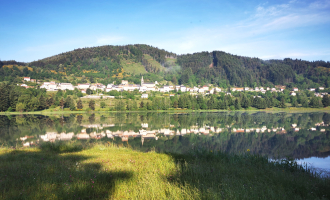Le Gouléïou
Ardèche ()

The lava, emitted at a temperature of 700 to 800°C, was too pasty to spread out and accumulated above its point of emission. Far from matching the usual image of a volcano, with its cone and crater, it was a simple fracture open towards the surface.
The particular conditions that governed the formation of this relief (temperature of the lava at the time of emission, degree of viscosity, speed of ascent to the surface, shape of the feeder pipe) explain its unique shape, which is unparalleled in the surrounding area.
Like all the phonolite reliefs in this sector, Gouléïou must have appeared between 8.5 and 6.5 million years ago, at the end of the construction of the Eastern Velay.
It thus post-dates the great basaltic plateaux of the Saint-Clément type, which the phonolite had to cross via fissures to reach the surface.
The emission of phonolites gave rise to a very dangerous type of eruptive dynamism, known as pelean (from Montagne Pelée in Martinique). The violent explosions that characterise this type of volcanism are linked to the accumulation of gases contained in the magma as it rises. They are the source of the famous "nuées ardentes", avalanches of rocky debris mixed with hot, toxic gases, with devastating effects.
All year round.
TarifsFree access.
Contact et accès 07310 BoréeArdèche (7)
Informations complémentaires
Ça peut vous intéresser


Le Maar de Borée-Echamps


Le Mont Gerbier de Jonc


Group accommodation Genestou


Dolmen des Beaumes


Le Mont Mézenc


Le Gouléïou


Le hêtre de Borée


Mézenc Marmots


Saint Martial Lake


Producteurs de Violine de Borée


Suc de Touron


Gîte Le Hameau gourmand


Itinéraire de randonnée “le cirque des Boutières – Mont Mézenc” – Borée

La Maison Forestière

Scierie Rochette

La Maison Forestière du Mézenc

Le Francillon

Dolmen des Beaumes

Domaine Nordique du Mézenc

Les Fermiers du Mézenc

Gîte d’étape communal

Aux mille étoiles de Sara

Le P’tit Chalet du Mézenc

Réveillon raquettes aux pieds… du massif du Mézenc




